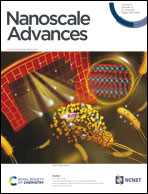Morphology-dependent fluorescence of europium-doped cerium oxide nanomaterials†
Abstract
Europium-doped CeO2 nanomaterials have been investigated for a variety of sensing and biological applications, as doping enhances the catalytic activity of CeO2 and contributes visible fluorescence to the nanomaterial. However, scant evidence is available that directly compares Eu3+ fluorescence from multiple morphologies establishing useful correlation(s) between physical and optical trends in such structures. To address this shortcoming, Eu3+-doped CeO2 nanorods, nanowires, nanocubes, and annealed nanorods were synthesized and characterized, representing a range of crystalline defect sizes, defect concentrations, and surface moieties. Morphologies rich with oxygen defects and hydroxyl groups (assessed via X-ray photoelectron spectroscopy) quenched the Eu3+ fluorescence, while samples with larger crystalline domains and lower Ce3+ concentrations have relatively stronger emission intensities. Of the four morphologies, nanocubes exhibit the strongest emission, as each structure is monocrystalline with few oxygen defects and associated quenching sites. Furthermore, the Eu3+ hypersensitive transition is more responsive to the dopant concentration in the nanocubes, as defects induced by the dopant are not removed by thermal annealing.



 Please wait while we load your content...
Please wait while we load your content...